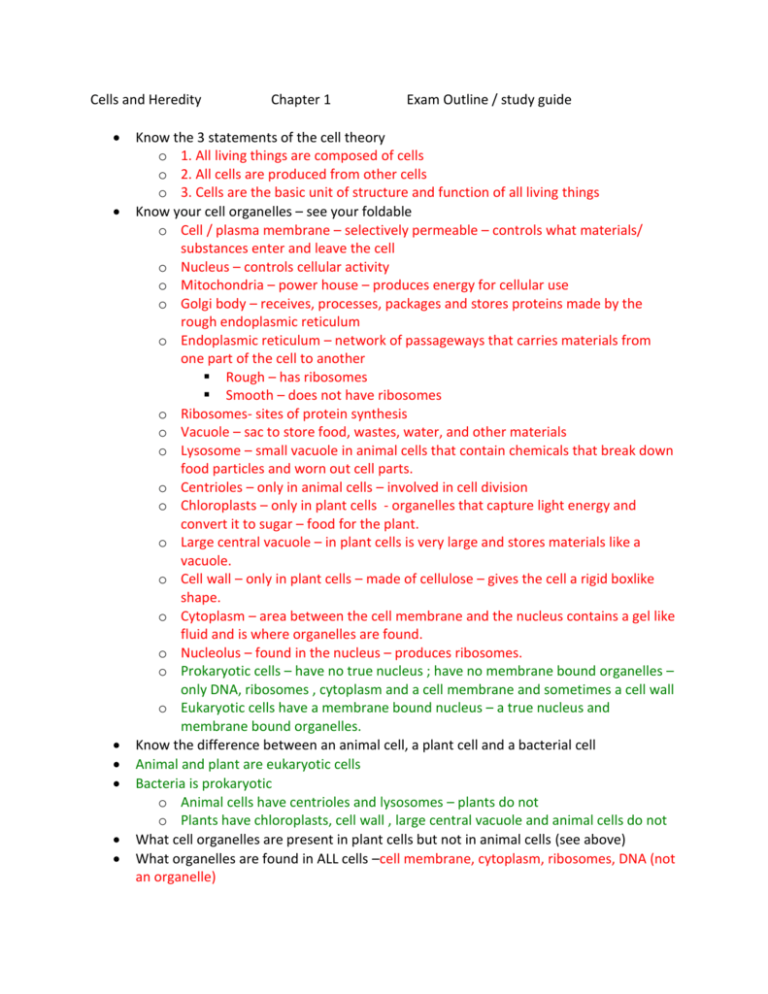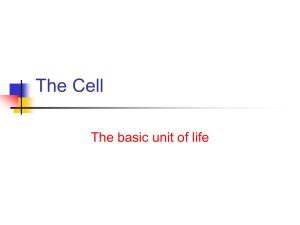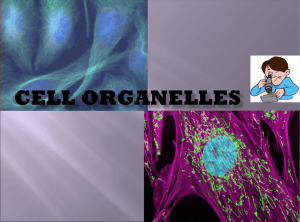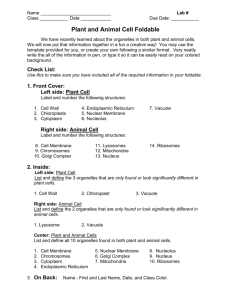Cells-and-Heredity-Chapter-1-Exam-Outline answers
advertisement

Cells and Heredity Chapter 1 Exam Outline / study guide Know the 3 statements of the cell theory o 1. All living things are composed of cells o 2. All cells are produced from other cells o 3. Cells are the basic unit of structure and function of all living things Know your cell organelles – see your foldable o Cell / plasma membrane – selectively permeable – controls what materials/ substances enter and leave the cell o Nucleus – controls cellular activity o Mitochondria – power house – produces energy for cellular use o Golgi body – receives, processes, packages and stores proteins made by the rough endoplasmic reticulum o Endoplasmic reticulum – network of passageways that carries materials from one part of the cell to another Rough – has ribosomes Smooth – does not have ribosomes o Ribosomes- sites of protein synthesis o Vacuole – sac to store food, wastes, water, and other materials o Lysosome – small vacuole in animal cells that contain chemicals that break down food particles and worn out cell parts. o Centrioles – only in animal cells – involved in cell division o Chloroplasts – only in plant cells - organelles that capture light energy and convert it to sugar – food for the plant. o Large central vacuole – in plant cells is very large and stores materials like a vacuole. o Cell wall – only in plant cells – made of cellulose – gives the cell a rigid boxlike shape. o Cytoplasm – area between the cell membrane and the nucleus contains a gel like fluid and is where organelles are found. o Nucleolus – found in the nucleus – produces ribosomes. o Prokaryotic cells – have no true nucleus ; have no membrane bound organelles – only DNA, ribosomes , cytoplasm and a cell membrane and sometimes a cell wall o Eukaryotic cells have a membrane bound nucleus – a true nucleus and membrane bound organelles. Know the difference between an animal cell, a plant cell and a bacterial cell Animal and plant are eukaryotic cells Bacteria is prokaryotic o Animal cells have centrioles and lysosomes – plants do not o Plants have chloroplasts, cell wall , large central vacuole and animal cells do not What cell organelles are present in plant cells but not in animal cells (see above) What organelles are found in ALL cells –cell membrane, cytoplasm, ribosomes, DNA (not an organelle) How do you calculate the total magnification when using a compound light microscope Multiply the ocular magnifying power times the objective magnifying power What did the invention of the microscope make possible – to observe living things not visible to the naked eye - microscopic What makes a compound organic – it contains carbon What is a compound – is formed when 2 or more elements combine chemically What is an element any substance that cannot be broken down into simpler substances What do sugar molecules combine they form? – starch , which is a complex carbohydrate What do amino acids form when they combine? proteins What type of organic compound are sugars and starch? carbohydrates What type of organic compound are fats, oils and waxes? lipids What type of organic compound are made of amino acids? proteins What type of organic compound is our hereditary material? a nucleic acid DNA – deoxyribonucleic acid What type of organic compound is involved in protein synthesis? Nucleic acid – RNA – ribonucleic acid Why is water so important to living things? Without water most chemical reactions within cells could not take place. Most substances dissolve in water; helps cells keep their shape and size; because of waters specific heat – the temperature of cells does not change rapidly and they can maintain a constant temperature. What is transport ? the movement of materials into or out of the cell across the cell membrane What is the difference between active and passive transport – list 2 differences o Active transport – requires energy and moves materials for a place of low concentration to a place of high concentration ( the boulder up the hill) o Passive transport – does not require energy and moves materials form a place of high concentration to a place of lower concentration ( the boulder rolling down the hill) What are 2 types of active transport and explain what happens in each type. o Phagocytosis – the cell takes food in via a food vacuole – the cell “eats”. The cell “engulfs” food and takes it in via a vacuole – example – ameba or a white blood cell. o Pinocytosis – the cell “drinks” – takes dissolved material into the cell via a vacuole. What are 2 types of passive transport and explain what happens in each type. o Diffusion – materials move across the cell membrane from an area of high concentration to an area of low concentration o Osmosis – WATER is moved across the cell membrane from an area of high concentration to an area of low concentration When we did our diffusion through a membrane experiment why didn’t starch move through the membrane and iodine and sugar did? Starch was too large a molecule and sugar was not too large What determines what will pass through the cell membrane? Size and type of molecule What are enzymes - what type of organic molecule are they and what do they do? Enzymes are proteins , made up of amino acids ; they are made by cells and they speed up chemical reaction in living things. Cells in multi celled organisms are often different from each other and are specialized to perform different functions – have different jobs in the organism. Cells working together to perform a particular function are organized into a specific type of tissue. When tissues work together to perform a particular function they form an organ ; when organs work together to form a particular function they form an organ system = then = you! Contrast the mitochondria and chloroplasts – what do they do and in what type of cell are they found(plant/ animal or both). Both are membrane bound organelles ; mitochondria are found in both animal and plant cells and break down glucose and release energy to be used for cellular activity or cellular work. Chloroplasts are found just in plant cells and capture the energy from the sun – light energy – and convert light energy to glucose (sugar) which is food for the plant. The plant uses this glucose in the mitochondria to produce cellular energy. Know the diagram of both the plant and animal cells. Be able to predict the movement of water molecules across a cell membrane based on concentration and be able to predict what the effect of osmosis will be on the cell. Effects of osmosis – o the cell will swell ( water moves into the cell ) and possibly burst ( animal cell) o the cell will shrink ( water moves out of the cell ) and the cell shrivels and possibly dies. Know all vocabulary on page 45 in text Resolution of the microscope refers to the sharpness of the image. The ability to clearly distinguish individual parts of an object. What type of organisms need a contractile vacuole and what is the function of the contractile vacuole? Protists – like a paramecium – who live in pond water. Water constantly flows from high to low into the paramecium and the paramecium stores this excess water in a contractile vacuole and then flushes it out so it does not explode and die. Watch the video - copy address into browser. http://www.youtube.com/watch?v=9Ynm5ZOW59Q What are pseudopods ? “false feet” used by single celled organisms to “engulf food – take in food . watch the ameba wrap its false feet = pseudopods around the paramecium and engulf them and eat them – this is phagocytosis. http://www.youtube.com/watch?v=pvOz4V699gk Review all power points, notes , quizzes and ipad cell packet of notes Review foldable of all the cell organelles – structure and function









